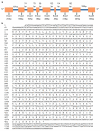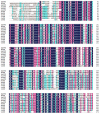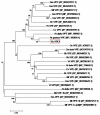A vacuolar processing enzyme RsVPE1 gene of radish is involved in floral bud abortion under heat stress
- PMID: 23807498
- PMCID: PMC3742190
- DOI: 10.3390/ijms140713346
A vacuolar processing enzyme RsVPE1 gene of radish is involved in floral bud abortion under heat stress
Abstract
Radish floral bud abortion (FBA) is an adverse biological phenomenon that occurs during reproduction. Although FBA is a frequent occurrence, its molecular mechanism remains unknown. A transcript-derived fragment (TDF72), which was obtained by cDNA amplified fragment length polymorphism (cDNA-AFLP), was up-regulated in the aborted buds and exhibited 89% sequence homology with the AtγVPE gene. In this study, TDF72 was used to clarify the role of VPE in FBA by isolation of the VPE gene RsVPE1 from radish flower buds. The full-length genomic DNA was 2346 bp including nine exons and eight introns. The full-length cDNA was 1825 bp, containing a complete open reading frame (ORF) of 1470 bp, which encoded a predicted protein containing 489 amino acid residues, with a calculated molecular mass of 53.735 kDa. Expression analysis demonstrated that RsVPE1 was expressed in all tested organs of radish at different levels. Highest expression was detected in aborted flower buds, suggesting that RsVPE1 has a role in FBA. In order to analyze the role of RsVPE1 in FBA, RsVPE1 was overexpressed in transgenic Arabidopsis thaliana plants. Aborted flower buds appeared in transgenic plants subjected to heat stress. In addition, RsVPE1 expression in the transgenic plants reached a maximum when subjected to heat stress for 24 h and increased by 2.1-fold to 2.8-fold in three homozygous transgenic lines. These results indicated that RsVPE1 led to FBA when its expression levels exceeded a particular threshold, and provided evidence for the involvement of RsVPE1 in promoting FBA under heat stress.
Figures








Similar articles
-
Analysis of differential gene expression during floral bud abortion in radish (Raphanus sativus L.).Genet Mol Res. 2013 Jul 24;12(3):2507-16. doi: 10.4238/2013.July.24.5. Genet Mol Res. 2013. PMID: 23979885
-
Expressed sequence tags of radish flower buds and characterization of a CONSTANS LIKE 1 gene.Mol Cells. 1998 Aug 31;8(4):452-8. Mol Cells. 1998. PMID: 9749533
-
The sequence and expression of the gamma-VPE gene, one member of a family of three genes for vacuolar processing enzymes in Arabidopsis thaliana.Plant Cell Physiol. 1995 Dec;36(8):1555-62. Plant Cell Physiol. 1995. PMID: 8589932
-
Homologues of a vacuolar processing enzyme that are expressed in different organs in Arabidopsis thaliana.Plant Mol Biol. 1995 Oct;29(1):81-9. doi: 10.1007/BF00019120. Plant Mol Biol. 1995. PMID: 7579169
-
The noble radish: past, present and future.Trends Plant Sci. 2003 Jul;8(7):305-7. doi: 10.1016/S1360-1385(03)00127-4. Trends Plant Sci. 2003. PMID: 12878009 Review.
Cited by
-
Characterization of a vacuolar processing enzyme expressed in Arachis diogoi in resistance responses against late leaf spot pathogen, Phaeoisariopsis personata.Plant Mol Biol. 2015 May;88(1-2):177-91. doi: 10.1007/s11103-015-0318-x. Epub 2015 Apr 17. Plant Mol Biol. 2015. PMID: 25893777
-
Gene Cloning, Expression and Enzyme Activity of Vitis vinifera Vacuolar Processing Enzymes (VvVPEs).PLoS One. 2016 Aug 23;11(8):e0160945. doi: 10.1371/journal.pone.0160945. eCollection 2016. PLoS One. 2016. PMID: 27551866 Free PMC article.
-
OsVPE3 Mediates GA-induced Programmed Cell Death in Rice Aleurone Layers via Interacting with Actin Microfilaments.Rice (N Y). 2020 Mar 30;13(1):22. doi: 10.1186/s12284-020-00376-6. Rice (N Y). 2020. PMID: 32232682 Free PMC article.
-
Suppression of OsVPE3 Enhances Salt Tolerance by Attenuating Vacuole Rupture during Programmed Cell Death and Affects Stomata Development in Rice.Rice (N Y). 2016 Dec;9(1):65. doi: 10.1186/s12284-016-0138-x. Epub 2016 Nov 29. Rice (N Y). 2016. PMID: 27900724 Free PMC article.
-
Normal and Abortive Buds Transcriptomic Profiling of Broccoli ogu Cytoplasmic Male Sterile Line and Its Maintainer.Int J Mol Sci. 2018 Aug 24;19(9):2501. doi: 10.3390/ijms19092501. Int J Mol Sci. 2018. PMID: 30149512 Free PMC article.
References
-
- Krupnick G.A., Avila G., Brown K.M., Stephenson A.G. Effects of herbivory on internal ethylene production and sex expression in Cucurbita texana. Funct. Ecol. 2000;14:215–225.
-
- Mouhouche B., Ruget F., Delecolle R. Effects of water stress applied at different phenological phases on yield components of dwarf bean (Phaseolus vulgaris L.) Agronomie. 1998;18:197–207.
-
- Ahmed F.E., Hall A.E. Heat injury during early floral bud development in cowpea. Crop Sci. 1993;33:764–767.
-
- Bosac C., Black V.J., Black C.R., Roberts J.A., Lockwood F. Impact of O3 and SO2 on reproductive development in oilseed rape (Brassica napus L.). I. Pollen germination and pollen tube growth. New Phytol. 1993;124:439–446.
-
- Zhang L.G., Jia J., Zhang S.L., Zhang Y. cDNA-AFLP differential expression analysis of genes related with aborting bud in Chinese cabbage. J. Agric. Biotechnol. 2010;18:489–492.
Publication types
MeSH terms
Substances
LinkOut - more resources
Full Text Sources
Other Literature Sources

